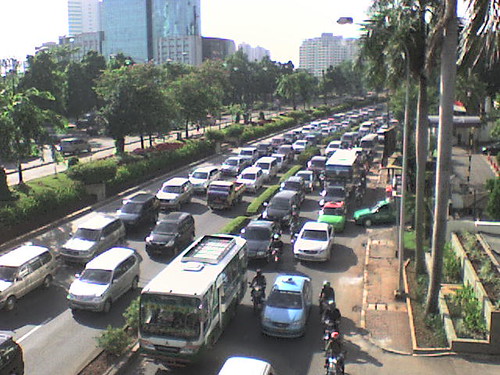
Setiabudi Macet 1, originally uploaded by susiloadhy. When a new highway was built or a road was widened, it will only solve the traffic congestion for a short period of time. After a few years, the new highway will fill with traffic that would not have existed if the highway had not been built. Similarly, the widened road fills with more traffic in a few months. Such phenomenon is called induced demand. Because of the induced demand, neither building new roads nor widening roads are the long-lasting solution to traffic congestion.
There are several possible solutions to eradicate traffic congestion problems and one of them is the reduction of private vehicle uses. I read an article in the New York Times (May 12, 2009) on a suburb town without cars in Germany with great interest. Streets in this upscale town are completely car-free except the main thoroughfare and a few streets on on edge of the town. The residents of this town are still allowed to own cars, but parking is relegated to two large garages at the edge of the development.
The Vauban town, is located on the outskirt of Freiburg, near the French and Swiss borders and home to 5,500 residents. The residents are heavily dependent on the tram to downtown Freiburg and many of them take to car-sharing when longer excursions are needed. Seventy percent of Vauban's families have no cars. They do a lot of walking and biking to shops, banks, restaurants, schools and other destinations that are interspersed among homes. The town is long and relatively narrow and provides an easy walking access to the tram for every home.
Creating places with more compact design, more accessible to public transportation and less driving is the envision of urban planners in the 21st century. The Vauban town is an exemplar of the 21st century urban design in response to the threats of greenhouse gas emission and global warming and the dwindling oil supply.
I could argue that the Vauban's urban design is the extention of the New Urbanism. The New Urbanism is a school of urban design arose in the U.S. in the early 1980s. This school of urban design promotes several key principles including walkability and connectivity, mixed land uses, and high density. There have been many the New Urbanist towns in several countries, but cars still fill the streets of these towns.
The Vauban town provides an example of the possibility of creating city without cars. The walkable and mixed-land-uses urban design, easy access to public transportation and excellent public transportation system as demonstrated in the Vauban town are the components for creating city without cars.
Cars are still a luxury item for many Indonesian families. Many urban residents, particularly those live in kampung kota, do not own cars and are used to living without cars. Streets (gang) in Indonesia's kampung kota are too narrow for cars and the residents are used to walking and biking to their destinations. Kampung kotas are located in the center of urban areas and relatively accessible to public transportations. In reference to the New Urbanism concept, the Indonesia's kampung kota has implemented the principles of walkability and high density.
Indonesian planners need to appreciate the existence of kampung kota in terms of lacking driving needs. Kampung kota residents will be less likely to have a demand for cars when their neighborhoods are accessible to public transportations and the streets in their neighborhoods remain narrow. Kampung kota residents need to remain lack of driving needs for reducing the car ownership rate in urban areas.
For new developments in suburb areas, Indonesian planners can emulate the success of the Vauban town. Driving needs are profoundly affected by the urban design and the high access to public transportation. It makes sense to envision and is not all impossible to create a city without cars.
(This article also appeared at The Jakarta Post on June 2, 2009)
Envisioning City without Cars
Traffic congestion is one of the chronic problems in most Indonesian cities and this problem is getting worse year by year. The growth of road developments in Indonesian cities is much slower than the growth rate of vehicle ownership. In Jakarta, for example, the growth rate of vehicle ownership is 9 to 11 percent per year but the growth of road developments is only less than 1 percent per year.
Subscribe to:
Post Comments (Atom)

























0 comments:
Post a Comment